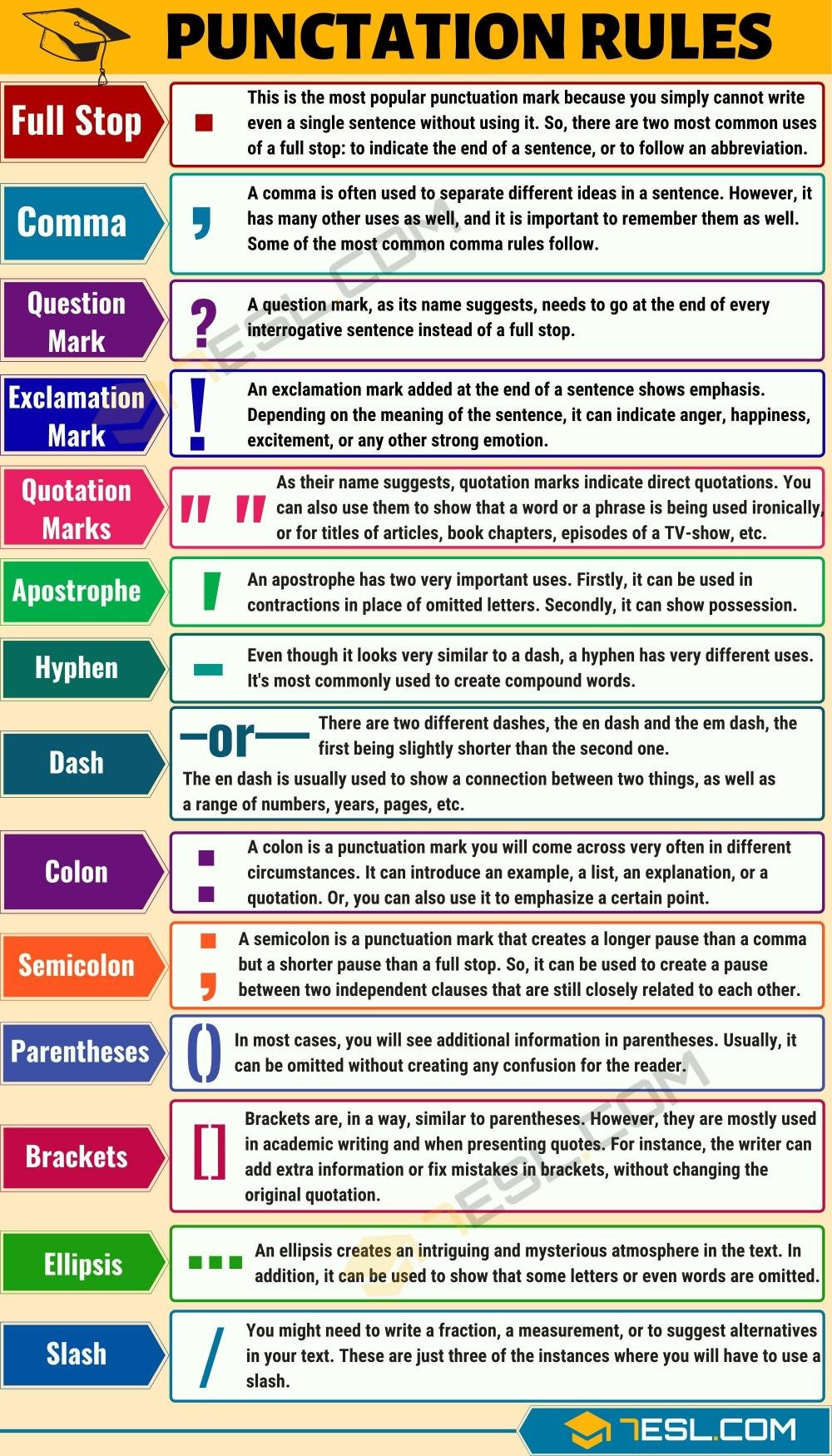Punctuation in English often differs in many ways from punctuation in other languages. This can be an issue, especially for non-native English learners all across the world. What is punctuation? Check out these useful punctuation rules in English below.

Here is our complete guide on punctuation rules and punctuation marks in the English language. Fnd out how and when to use different punctuation marks with useful examples.
Full Stop / Period (.)
This is the most popular punctuation mark because you simply cannot write a single sentence without using it. There are two main uses of a full stop: to indicate the end of a sentence, or to follow an abbreviation.
Comma (,)
A comma is often used to separate different ideas in a sentence. However, it has many other uses as well. For example:
- Commas separate items in a list: apples, peaches, grapes, and oranges
- A comma is used after an introductory word or phrase: at the end of the day, however, in contrast, etc.
- A comma is used to distinguish a tag question at the end of your sentence fro the rest of the sentence: You are going to the party this Saturday, aren’t you?
- Use a comma when you are directly addressing someone: Julia, what would you like to eat for dinner?
Question Mark (?)
A question mark, as its name suggests, needs to go at the end of every interrogative sentence instead of a full stop:
- What did you do today?
- How are you doing?
- Where is your little brother?
Exclamation Mark (!)
Whe you add an exclamation mark at the end of a sentence, it shows emphasis. An exclamation mark can also indicate anger, happiness, excitement, or any other strong emotion, depending on the meaning of the sentence.
- Go away!
- I’m so excited to see you!
- I can’t wait to go to London!
Quotation Marks / Speech Marks (” “)
As you might expect form the name, quotation marks indicate direct quotations. You can also use them to show that a word or a phrase is being used ironically, or for titles of articles, book chapters, episodes of a TV-show, etc.
- “You’ll never believe what happened last night,” Amy said.
Apostrophe (‘)
An apostrophe has two very important uses. First, it can be used in contractions in place of omitted letters. Second, it can show possession.
- You don’t have to go to the store if you don’t want to.
- We should invite both of Tim's sisters to the party.
Hyphen (-)
Even though it looks very similar to a dash, a hyphen has very different uses. It’s most commonly used to create compound words.
- She has always been very self-conscious.
- My sister just started a new part-time job.
Dash (– or —)
In fact, there are two different dashes, the en dash and the em dash. The former is slightly shorter than the latter one. The en dash is usually used to show a connection between two things, as well as a range of numbers, years, pages, etc.
- The London–Paris flight takes about 1 hour and 15 minutes.
- For tomorrow’s lesson, I need to read pages 38–55 of the textbook.
The em dash can replace a comma, a colon, or parenthesis. You can also use it to put emphasis on the ending of your sentence.
- This year, Linda has traveled to quite a few countries—China, Japan, South Korea, and Vietnam.
- His answer was loud and clear—No!
Colon (:)
A colon is a punctuation mark used in many different circumstances. It can introduce an example, a list, an explanation, or a quotation. Or, you can also use it to emphasize a certain point.
- There are two things you can do: continue being miserable or move on with your life.
- There’s only one person in the world who can tell you what you should do: you.
Semicolon (;)
A semicolon is a punctuation mark that creates a longer pause than a comma but a shorter pause than a full stop. It can be used to create a pause between two independent clauses that are still closely related to each other.
- My mother is a teacher; my father is an salesman.
- Sylvia spent the whole morning trying to figure out what to wear; she ended up choosing the first outfit out of all that she tried on that day.
Parentheses ()
In most cases, you will see additional information in parentheses. Usually, it can be omitted without creating any confusion for the reader.
Brackets []
Brackets are, in a way, similar to parentheses. However, they are mostly used in academic writing and when presenting quotes. For instance, the writer can add extra information or fix mistakes in brackets, without changing the original quotation.
- The girl said, “I could hear him [my younger brother] but I couldn’t see him”.
Ellipsis (…)
When you want to creates an intriguing and mysterious atmosphere in the text, you use ellipsis. Additionally, it can be used to show that some letters or even words are omitted.
- So… what happened next?
Slash (/)
You might need to write a fraction, a measurement, or to suggest alternatives in your text. These are just three of the instances where you will have to use a slash.
- To make this cake, you will need 1/2 cup of milk, 2 cups of flour and 1 cup of sugar.
- The car was going as fast as 140 km/h.
- Just press the On/Off button.
Are you interested in teaching English as a foreign language?
Get your TEFL or TESOL certificate with ITTT.
Register now & get certified to teach english abroad!


